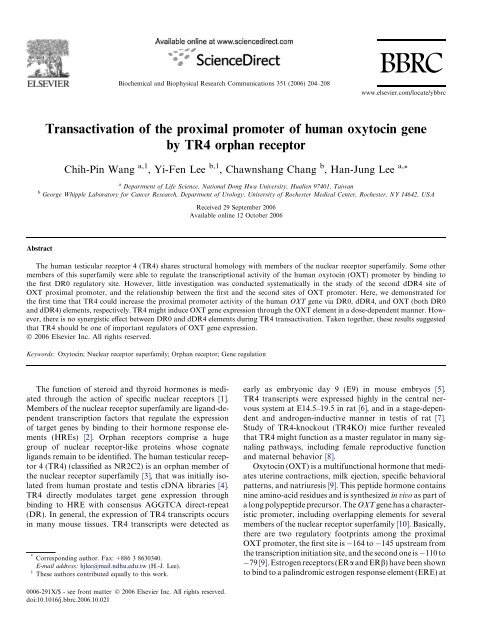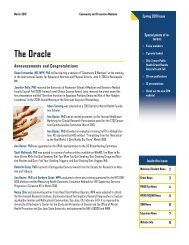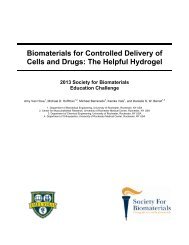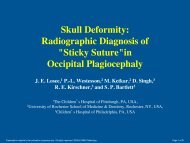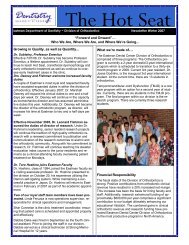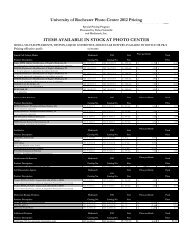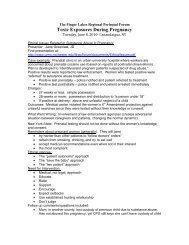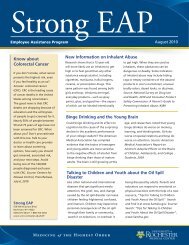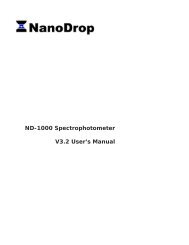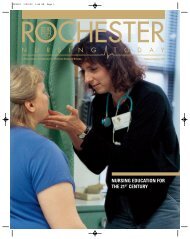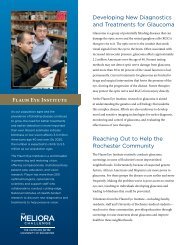Wang CP, Lee YF, Chang C and Lee HJ - University of Rochester ...
Wang CP, Lee YF, Chang C and Lee HJ - University of Rochester ...
Wang CP, Lee YF, Chang C and Lee HJ - University of Rochester ...
Create successful ePaper yourself
Turn your PDF publications into a flip-book with our unique Google optimized e-Paper software.
Biochemical <strong>and</strong> Biophysical Research Communications 351 (2006) 204–208BBRCwww.elsevier.com/locate/ybbrcTransactivation <strong>of</strong> the proximal promoter <strong>of</strong> human oxytocin geneby TR4 orphan receptorChih-Pin <strong>Wang</strong> a,1 , Yi-Fen <strong>Lee</strong> b,1 , Chawnshang <strong>Chang</strong> b , Han-Jung <strong>Lee</strong> a, *a Department <strong>of</strong> Life Science, National Dong Hwa <strong>University</strong>, Hualien 97401, Taiwanb George Whipple Laboratory for Cancer Research, Department <strong>of</strong> Urology, <strong>University</strong> <strong>of</strong> <strong>Rochester</strong> Medical Center, <strong>Rochester</strong>, NY 14642, USAReceived 29 September 2006Available online 12 October 2006AbstractThe human testicular receptor 4 (TR4) shares structural homology with members <strong>of</strong> the nuclear receptor superfamily. Some othermembers <strong>of</strong> this superfamily were able to regulate the transcriptional activity <strong>of</strong> the human oxytocin (OXT) promoter by binding tothe first DR0 regulatory site. However, little investigation was conducted systematically in the study <strong>of</strong> the second dDR4 site <strong>of</strong>OXT proximal promoter, <strong>and</strong> the relationship between the first <strong>and</strong> the second sites <strong>of</strong> OXT promoter. Here, we demonstrated forthe first time that TR4 could increase the proximal promoter activity <strong>of</strong> the human OXT gene via DR0, dDR4, <strong>and</strong> OXT (both DR0<strong>and</strong> dDR4) elements, respectively. TR4 might induce OXT gene expression through the OXT element in a dose-dependent manner. However,there is no synergistic effect between DR0 <strong>and</strong> dDR4 elements during TR4 transactivation. Taken together, these results suggestedthat TR4 should be one <strong>of</strong> important regulators <strong>of</strong> OXT gene expression.Ó 2006 Elsevier Inc. All rights reserved.Keywords: Oxytocin; Nuclear receptor superfamily; Orphan receptor; Gene regulationThe function <strong>of</strong> steroid <strong>and</strong> thyroid hormones is mediatedthrough the action <strong>of</strong> specific nuclear receptors [1].Members <strong>of</strong> the nuclear receptor superfamily are lig<strong>and</strong>-dependenttranscription factors that regulate the expression<strong>of</strong> target genes by binding to their hormone response elements(HREs) [2]. Orphan receptors comprise a hugegroup <strong>of</strong> nuclear receptor-like proteins whose cognatelig<strong>and</strong>s remain to be identified. The human testicular receptor4 (TR4) (classified as NR2C2) is an orphan member <strong>of</strong>the nuclear receptor superfamily [3], that was initially isolatedfrom human prostate <strong>and</strong> testis cDNA libraries [4].TR4 directly modulates target gene expression throughbinding to HRE with consensus AGGTCA direct-repeat(DR). In general, the expression <strong>of</strong> TR4 transcripts occursin many mouse tissues. TR4 transcripts were detected as* Corresponding author. Fax: +886 3 8630340.E-mail address: hjlee@mail.ndhu.edu.tw (H.-J. <strong>Lee</strong>).1 These authors contributed equally to this work.early as embryonic day 9 (E9) in mouse embryos [5].TR4 transcripts were expressed highly in the central nervoussystem at E14.5–19.5 in rat [6], <strong>and</strong> in a stage-dependent<strong>and</strong> <strong>and</strong>rogen-inductive manner in testis <strong>of</strong> rat [7].Study <strong>of</strong> TR4-knockout (TR4KO) mice further revealedthat TR4 might function as a master regulator in many signalingpathways, including female reproductive function<strong>and</strong> maternal behavior [8].Oxytocin (OXT) is a multifunctional hormone that mediatesuterine contractions, milk ejection, specific behavioralpatterns, <strong>and</strong> natriuresis [9]. This peptide hormone containsnine amino-acid residues <strong>and</strong> is synthesized in vivo as part <strong>of</strong>a long polypeptide precursor. The OXT gene has a characteristicpromoter, including overlapping elements for severalmembers <strong>of</strong> the nuclear receptor superfamily [10]. Basically,there are two regulatory footprints among the proximalOXT promoter, the first site is 164 to 145 upstream fromthe transcription initiation site, <strong>and</strong> the second one is 110 to79 [9]. Estrogen receptors (ERa <strong>and</strong> ERb) have been shownto bind to a palindromic estrogen response element (ERE) at0006-291X/$ - see front matter Ó 2006 Elsevier Inc. All rights reserved.doi:10.1016/j.bbrc.2006.10.021
C.-P. <strong>Wang</strong> et al. / Biochemical <strong>and</strong> Biophysical Research Communications 351 (2006) 204–208 205the first site <strong>of</strong> the proximal promoter <strong>of</strong> the human OXTgene. This palindromic ERE overlaps with a directAGGTCA repeat, corresponding to a natural variant <strong>of</strong> aso-called DR0 (direct-repeat spaced by 0 nucleotide). Thesecond regulatory site contains three copies <strong>of</strong> AGGTCArepeat spaced by four nucleotides each, corresponding to adouble-DR4 (dDR4).Materials <strong>and</strong> methodsPlasmid constructions. pCMX-TR4 <strong>and</strong> pET14b-TR4 were describedpreviously [11,12]. pGL3-OXT-DR0 plasmid containing one copy <strong>of</strong> theDR0 element was generated by insertion <strong>of</strong> two annealing primers OXT-DR0U (5 0 -GATCGGTGACCTTGACCCCG-3 0 ) <strong>and</strong> OXT-DR0D (5 0 -GATCCGGGGTCAAGGTCACC-3 0 ) at BglII site <strong>of</strong> pGL3-Promotervector (Promega). pGL3-OXT-dDR4 plasmid consisting <strong>of</strong> one copy <strong>of</strong>the dDR4 element was constructed by insertion <strong>of</strong> two annealing primersOXT-dDR4U (5 0 -GATCCCTGACCCACGGCGACCCTCTGTGACCAAT-3 0 ) <strong>and</strong> OXT-dDR4D (5 0 -GATCATTGGTCACAGAGGGTCGCCGTGGGTCAGG-3 0 ) at BglII site <strong>of</strong> pGL3-Promoter. pGL3-OXTplasmid containing one copy <strong>of</strong> the OXT element (including both DR0<strong>and</strong> dDR4 elements) was generated by insertion <strong>of</strong> two annealing longprimers OXT-U (5 0 -GATCTGACCTTGACCCCGCCTGACCCACGGCGACCCTCTGTGACCA-3 0 ) <strong>and</strong> OXT-D (5 0 -GATCTGGTCACAGAGGGTCGCCGTGGGTCAGGCGGGGTCAAGGTCA-3 0 )atBglIIsite <strong>of</strong> pGL3-Promoter. All plasmids were sequenced by the ABI PRISM3100-Avant Genetic Analyzer (Applied Biosystems). DNA plasmid waspurified with the Nucleobond AX-100 Kit (Macherey-Nagel) according tothe manufacturer’s protocol.Western blot analysis. TR4 protein was overexpressed from pET14b-TR4-transformed Escherichia coli <strong>and</strong> purified with His-Bind column aspreviously described [13–15]. Western blot analysis was employed asdescribed previously [16]. Briefly, 1 lg <strong>of</strong> TR4 protein was separated bySDS–PAGE on a 12% polyacrylamide gel <strong>and</strong> electroblotted onto aPVDF membrane (Amersham) according to the manufacturer’s protocol.After nonspecific blocking, the membrane was treated with rabbit anti-6his antibody (Bethyl), followed by HRP-conjugated goat anti-rabbit Igantibody (MDBio, Taiwan), <strong>and</strong> then visualized by an enhanced chemiluminescencedetection kit (ECL Plus Western Blotting Detection System,Amersham).Electrophoretic mobility shift assay (EMSA). This assay was conductedmainly as previously described [17]. TR4 protein was generatedfrom a coupled in vitro transcription <strong>and</strong> translation system as previouslydescribed [11,17]. A 42 bp double-str<strong>and</strong>ed oligonucleotide OXT probewas generated by annealing <strong>of</strong> primers OXT-U <strong>and</strong> OXT-D <strong>and</strong> digoxigenin(DIG)-labeled (Roche) according to the manufacturer’s protocol.Transient transfection <strong>and</strong> dual-luciferase assays. Human lung cancerA549 cells (American Type Culture Collection, CCL-185) were cultured aspreviously described [14]. Transient transfection <strong>and</strong> dual-luciferase assayswere conducted as previously described [12,18,19].ResultsEvolutionary sequence conservation among promoters <strong>of</strong>OXT genesTwo regulatory footprints <strong>of</strong> the human OXT promoterare located between 167 <strong>and</strong> 149 (the first site, correspondingto nucleotide numbers 215 <strong>and</strong> 233 <strong>of</strong> AccessionNo. M11186, GenBank), <strong>and</strong> between 105 <strong>and</strong> 76 (thesecond site) (Fig. 1A). In the first site, a DR0 element isbetween nucleotide numbers 220 <strong>and</strong> 231, overlapping witha palindromic ERE. Consensus sequences <strong>of</strong> the DR0 elementin rat, mouse, <strong>and</strong> bovine showed 100, 100, <strong>and</strong>91.7% homologies with that <strong>of</strong> human, respectively. Inthe second site, a dDR4 element contains three copies <strong>of</strong>AGGTCA consensus motif spaced by four nucleotideseach in human (nucleotide numbers 279 <strong>and</strong> 304) <strong>and</strong>bovine promoters, while one nucleotide deleted in a spaceregion in rat <strong>and</strong> mouse promoters. Consensus sequences<strong>of</strong> dDR4 in rat, mouse, <strong>and</strong> bovine displayed 88.9, 83.3,<strong>and</strong> 88.9% homologies with that <strong>of</strong> human, respectively.These results suggested that OXT elements (includingDR0 <strong>and</strong> dDR4 elements) were evolutionally conservedamong these species.TR4 orphan receptor specifically binds to the human OXTproximal promoterTR4 was purified from cellular extracts isolated fromE. coli BL21(DE3) transformed with pET14b-TR4 expressingplasmid. TR4 protein was confirmed on a 12%SDS–PAGE, followed by Western blot analysis (Fig. 1B).TR4 protein corresponding to the expected molecular mass<strong>of</strong> 67.3 kDa could be detected in both isopropyl-b-D-thiogalactopyranoside(IPTG)-induced cellular lysates (lane 2)<strong>and</strong> eluent after purification (lane 3), but not in non-inducedlysates (lane 1).A 42 bp double-str<strong>and</strong>ed oligonucleotide OXT probewas generated by annealing two primers OXT-U <strong>and</strong>OXT-D, <strong>and</strong> DIG-labeled. TR4 protein was generatedfrom a coupled in vitro transcription <strong>and</strong> translation systemwith pET14b-TR4 plasmid. A specific DNA–protein complexwas revealed when TR4 was incubated with the OXTelement probe (Fig. 1C, lane 3). This DNA–protein complexcould be abolished in the presence <strong>of</strong> 100-fold molarexcess <strong>of</strong> unlabeled oligonucleotides (lane 4). NonspecificDNA–protein complexes appeared at the position rightbelow the specific complex in the mock-translated product(lane 2). These data indicated that TR4 could specificallybind to the OXT element <strong>of</strong> the human OXT proximal promoter.In addition, TR4 might also form specific DNA–protein complexes with DR0 <strong>and</strong> dDR4 elements in theEMSA, respectively (data not shown).TR4 activates OXT gene expression via DR0 <strong>and</strong> dDR4elementsTo investigate, whether TR4 could regulate the humanOXT gene expression through the interaction with proximalpromoter, we performed dual-luciferase assay inhuman A549 cells. Cells were co-transfected with variousluciferase reporter plasmids (Fig. 2) in the presence orabsence <strong>of</strong> pCMX-TR4 expression plasmid. In the case <strong>of</strong>DR0 <strong>and</strong> dDR4 elements, TR4 was able to activate luciferasereporter gene activities <strong>of</strong> the pGL3-OXT-DR0(Fig. 3A) <strong>and</strong> pGL3-OXT-dDR4 (Fig. 3B) plasmids,respectively. These results suggested that TR4 might induceOXT gene expression through DR0 <strong>and</strong> dDR4 elements inproximal promoter, respectively.
206 C.-P. <strong>Wang</strong> et al. / Biochemical <strong>and</strong> Biophysical Research Communications 351 (2006) 204–208Fig. 1. Interaction between TR4 <strong>and</strong> OXT promoter. (A) Sequences <strong>of</strong> the proximal OXT promoters. Identical sequence is shown in capital, but differencefrom the human sequence is indicated in lower-case. Nucleotide numbers from different species with the Accession Numbers (GenBank) are indicated,while minus numbers denote nucleotides before the transcription initiation site in human. Potential AGGTCA repeats are indicated by arrows undersequences, <strong>and</strong> an ERE is shown by arrows above sequences. (B) Western blot analysis <strong>of</strong> TR4. Protein samples were extracted either from non-inducedE. coli strain BL21 (DE3) (lane 1), IPTG-induced E. coli (lane 2), or after purification (lane 3). St<strong>and</strong>ard protein molecular masses are displayed on the left.TR4 protein, corresponding to the expected molecular mass <strong>of</strong> 67.3 kDa is indicated by an arrowhead. (C) Binding <strong>of</strong> the in vitro expressed TR4 to theOXT element. Lane 1 displays the DIG-labeled OXT probe alone. Binding reaction mixtures were incubated with the probe <strong>and</strong> either the mock-translatedproduct (lane 2) or the in vitro synthesized TR4 (lanes 3 <strong>and</strong> 4) in the presence <strong>of</strong> 100-fold molar excesses <strong>of</strong> unlabeled OXT (lane 4). The retardedcomplexes are indicated by an arrowhead for specific DNA–protein complexes, whereas nonspecific complexes appear below.The induction activity <strong>of</strong> OXT promoter by TR4 in a dosedependentfashionTo determine any synergistic effect between DR0 <strong>and</strong>dDR4 elements in the human OXT proximal promoter,A549 cells were transiently co-transfected with eitherpGL3-Promoter or pGL3-OXT reporter plasmid in thepresence or absence <strong>of</strong> pCMX-TR4 plasmid. In the case<strong>of</strong> the OXT element, TR4 could regularly activate luciferasereporter gene activity <strong>of</strong> the pGL3-OXT plasmid(Fig. 4A). These data indicated that TR4 might induceOXT gene expression through the OXT element withoutsynergistic effect between DR0 <strong>and</strong> dDR4 elements.To further reveal this transactivation <strong>of</strong> OXT proximalpromoter by TR4, cells were co-transfected with pGL3-OXT reporter plasmid <strong>and</strong> increasing amounts <strong>of</strong>pCMX-TR4 plasmid (Fig. 4B). Results showed that TR4could trigger the luciferase reporter activity via OXT proximalpromoter in a dose-dependent manner.DiscussionIn recent years, several reports have focused on the study<strong>of</strong> the multiple HREs at the first site <strong>of</strong> the proximal promoters<strong>of</strong> human or rat OXT genes. These studies revealedthat this multiple HRE is responsive to estrogen, thyroidhormone, or retinoids [10]. In addition, previous study indicatedthat two orphan receptors, steroidogenic factor 1(SF-1) <strong>and</strong> chicken ovalbumin upstream promoter transcriptionfactor (COUP-TF), preferentially bound to thisDR0 element in the bovine OXT promoter [20]. Thesetwo orphan receptors appeared to compete for binding tothis DR0 element, since SF-1 was associated with OXT geneactivation <strong>and</strong> COUP-TF with its repression. Subsequently,
C.-P. <strong>Wang</strong> et al. / Biochemical <strong>and</strong> Biophysical Research Communications 351 (2006) 204–208 207A1210*intensityrelative86420pGL3 pGL3+TR4 pGL3-DR0 pGL3-DR0 +TR4B76*intensity54Fig. 2. Schematic structure <strong>of</strong> reporter gene plasmids. pGL3-OXT-DR0,pGL3-OXT-dDR4, <strong>and</strong> pGL3-OXT plasmids contain one copy <strong>of</strong> DR0,dDR4, <strong>and</strong> the full-length regulatory OXT elements in the senseorientation at the multiple cloning site (MCS) in front <strong>of</strong> the simian virus40 (SV40) promoter <strong>and</strong> the modified coding region <strong>of</strong> luciferase reportergene (Luc + ) in the parent pGL3-Promoter vector, respectively.relative3210pGL3 pGL3 + TR4 pGL3-dDR4 pGL3-dDR4 +TR4Fig. 3. TR4 induction <strong>of</strong> luciferase reporter gene activity <strong>of</strong> the OXTproximal promoter via DR0 <strong>and</strong> dDR4 elements, respectively. (A)Functional assay with pGL3-OXT-DR0 plasmid. (B) Functional assaywith pGL3-OXT-dDR4 plasmid. Human A549 cells were transiently cotransfectedwith different pGL3 reporter plasmids (2 lg <strong>of</strong> each) <strong>and</strong> 1 lgphRL-TK internal control plasmid in the presence or absence <strong>of</strong> 2.5 lgpCMX-TR4 expressing plasmid. All firefly luciferase activities werenormalized with Renilla luciferase activities. Data represent means ± SD<strong>of</strong> three independent experiments performed in duplicate. Significantdifference (P < 0.05) between control <strong>and</strong> experimental groups is markedwith an asterisk.two COUP members (COUP-TFII <strong>and</strong> Ear-2) were identifiedto suppress basal OXT promoter activity via DR0 <strong>and</strong>dDR4 elements [9]. Especially, the dDR4 element wasessential for this silencing effect. The specific bindingpreference to the DR0 element was in the order <strong>of</strong>COUP-TF = TRa > SF-1 > RAR > ER [10]. Nevertheless,the complex formed between the breast cell nuclear extracts<strong>and</strong> the DR0 element exposed that an unknown transcriptionfactor remained to be identified. This factor was none<strong>of</strong> identified nuclear receptors, but was likely to be anothermember <strong>of</strong> the nuclear receptor superfamily [10].In the present study, we found that TR4 could directlybind to DR0, dDR4, <strong>and</strong> OXT elements, respectively.The TR4-DR0 binding complex could be abolished in thepresence <strong>of</strong> 100-fold molar excesses <strong>of</strong> unlabeled oligonucleotides,while the TR4-dDR4 complex might be impairedin the presence <strong>of</strong> only 30-fold molar excesses <strong>of</strong> competitors(data not shown). These data suggested that theDR0 element could be essential for mediating TR4 transactivationamong two regulatory sites. That is probably truedue to the consequence that TR4 possesses higher affinityto the DR0 element than the dDR4 element. Characterization<strong>of</strong> the binding preference <strong>of</strong> TR4 to synthetic DRsindicated in the order <strong>of</strong> DR6 > DR5 > DR1 > DR3 >DR2 > DR4 [12]. It is interesting to note that the dDR4element <strong>of</strong> the human OXT promoter may represent anothertype <strong>of</strong> two direct-repeats spaced by 14 nucleotides apart(DR14). The medium-chain ethyl coenzyme A dehydrogenasegene promoter contains a complex regulatory elementwith four hexamer binding sites <strong>of</strong> nuclear receptors [21].This regulatory element previously conferred transcriptionalregulation by ARA/RXR <strong>and</strong> HNF-4 orphan receptor.COUP family homodimers were able to interact <strong>and</strong> functionwith an everted repeat with the same spacing <strong>of</strong> 14nucleotides (ER14) <strong>of</strong> this gene promoter.OXT is produced in neurons <strong>of</strong> the paraventricular <strong>and</strong>supraoptic nuclei <strong>of</strong> the hypothalamus, as well as in specifictissues <strong>and</strong> cell types peripherally [22]. Physiological functions<strong>of</strong> OXT have been well studied, <strong>and</strong> this peptide hormoneis known to affect both central <strong>and</strong> peripheralsystems, as well as behavior. In order to prove OXT mightbe a TR4 target gene, more direct physiological evidencemay come from the study <strong>of</strong> TR4KO mice [8]. Results demonstratedhigh rates <strong>of</strong> early postnatal mortality <strong>and</strong> significantgrowth retardation in TR4KO mice. TR4KO femalesfurther showed defects in reproduction <strong>and</strong> maternalbehavior. Especially, the reduced OXT expression in the
208 C.-P. <strong>Wang</strong> et al. / Biochemical <strong>and</strong> Biophysical Research Communications 351 (2006) 204–208AintensityrelativeBintensityrelative1086420121086420hypothalamic regions <strong>of</strong> TR4KO mice [8] suggested thatthe defect in regulatory levels <strong>of</strong> this peptide hormone,resulting from the disruption <strong>of</strong> TR4 expression.AcknowledgmentsWe are grateful to Drs. Ming-Huan Chan <strong>and</strong> Jyh-Ching Chou for critical reading <strong>and</strong> editing <strong>of</strong> the manuscript.This work was supported by the National ScienceCouncil, Taiwan.ReferencespGL3 pGL3 + TR4 pGL3-OXT pGL3-OXT +TR40 0.25 0.5 1 2 4 6amount <strong>of</strong> TR4 (microgram)Fig. 4. TR4 Induction <strong>of</strong> luciferase reporter gene activity <strong>of</strong> the OXTproximal promoter via the OXT element in a dose-dependent manner. (A)Functional assay with pGL3-OXT plasmid. (B) Functional assay <strong>of</strong>dosage effect with pGL3-OXT plasmid. A549 cells were co-transfectedwith 2 lg pGL3-OXT reporter plasmid <strong>and</strong> 1 lg phRL-TK internalcontrol plasmid in the presence <strong>of</strong> serially increasing amounts <strong>of</strong> pCMX-TR4 (0.25–6 lg) expressing plasmid.[1] R.M. Evans, The steroid <strong>and</strong> thyroid hormone receptor superfamily,Science 240 (1988) 889–895.[2] D.J. Mangelsdorf, C. Thummel, M. Beato, P. Herrlich, G. Schutz, K.Umesono, B. Blumberg, P. Kastner, M. Mark, P. Chambon, R.M.Evans, The nuclear receptor superfamily: the second decade, Cell 83(1995) 835–839.[3] Y.F. <strong>Lee</strong>, H.J. <strong>Lee</strong>, C. <strong>Chang</strong>, Recent advances in the TR2 <strong>and</strong> TR4orphan receptors <strong>of</strong> the nuclear receptor superfamily, J. SteroidBiochem. Mol. Biol. 81 (2002) 291–308.*[4] C. <strong>Chang</strong>, S. Lopes da Silva, R. Ideta, Y. <strong>Lee</strong>, S. Yeh, J.P.H.Burbach, Human <strong>and</strong> rat TR4 orphan receptors specify a subclass <strong>of</strong>the steroid receptor superfamily, Proc. Natl. Acad. Sci. USA 91(1994) 6040–6044.[5] W.J. Young, S. Smith, C. <strong>Chang</strong>, Induction <strong>of</strong> the intronic enhancer<strong>of</strong> the human ciliary neurotrophic factor receptor (CNTFRa) gene bythe TR4 orphan receptor, a member <strong>of</strong> steroid receptor superfamily,J. Biol. Chem. 272 (1997) 3109–3116.[6] H.S.A. van Schaick, J.G.M. Rosmalen, S. Lopes da Silva, C. <strong>Chang</strong>,J.P.H. Burbach, Expression <strong>of</strong> the orphan receptor TR4 during braindevelopment <strong>of</strong> the rat, Mol. Brain Res. 77 (2000) 104–110.[7] X. Mu, L. Yang, C. <strong>Chang</strong>, Stage dependent <strong>and</strong> <strong>and</strong>rogen inductiveexpression <strong>of</strong> orphan receptor TR4 in rat testis, Biochem. Biophys.Res. Commun. 341 (2006) 464–469.[8] L.L. Collins, Y.F. <strong>Lee</strong>, C.A. Heinlein, N.C. Liu, Y.T. Chen, C.R. Shyr,C.K. Meshul, H. Uno, K.A. Platt, C. <strong>Chang</strong>, Growth retardation <strong>and</strong>abnormal maternal behavior in mice lacking testicular orphan nuclearreceptor 4, Proc. Natl. Acad. Sci. USA 101 (2004) 15058–15063.[9] K. Chu, H.H. Zingg, The nuclear orphan receptors COUP-TFII <strong>and</strong>Ear-2 act as silencers <strong>of</strong> the human oxytocin gene promoter, J. Mol.Endocrinol. 19 (1997) 163–172.[10] K. Stedronsky, R. Telgmann, G. Tillmann, N. Walther, R. Ivell, Theaffinity <strong>and</strong> activity <strong>of</strong> the multiple hormone response element in theproximal promoter <strong>of</strong> the human oxytocin gene, J. Neuroendocrinol.14 (2002) 472–485.[11] H.J. <strong>Lee</strong>, Y. <strong>Lee</strong>, J.P.H. Burbach, C. <strong>Chang</strong>, Suppression <strong>of</strong> geneexpression on the simian virus 40 major late promoter by human TR4orphan receptor. A member <strong>of</strong> the steroid receptor superfamily, J.Biol. Chem. 270 (1995) 30129–30133.[12] H.J. <strong>Lee</strong>, Y.F. <strong>Lee</strong>, C. <strong>Chang</strong>, TR4 orphan receptor represses thehuman steroid 21-hydroxylase gene expression through the monomericAGGTCA motif, Biochem. Biophys. Res. Commun. 285 (2001)1361–1368.[13] M. <strong>Chang</strong>, J.C. Chou, H.J. <strong>Lee</strong>, Cellular internalization <strong>of</strong> fluorescentproteins via arginine-rich intracellular delivery peptide in plant cells,Plant Cell Physiol. 46 (2005) 482–488.[14] Y.H. <strong>Wang</strong>, C.P. Chen, M.H. Chan, M. <strong>Chang</strong>, Y.W. Hou, H.H.Chen, H.R. Hsu, K. Liu, H.J. <strong>Lee</strong>, Arginine-rich intracellular deliverypeptides noncovalently transport protein into living cells, Biochem.Biophys. Res. Commun. 346 (2006) 758–767.[15] Y.L. Lin, Y.H. <strong>Wang</strong>, H.J. <strong>Lee</strong>, Transcriptional regulation <strong>of</strong> thehuman TR2 orphan receptor gene by nuclear factor 1-A, Biochem.Biophys. Res. Commun. 350 (2006), in press.[16] H.J. <strong>Lee</strong>, W.J. Young, C.C.Y. Shih, C. <strong>Chang</strong>, Suppression <strong>of</strong> thehuman erythropoietin gene expression by the human TR2 orphanreceptor, a member <strong>of</strong> the steroid receptor superfamily, J. Biol. Chem.271 (1996) 10405–10412.[17] H.J. <strong>Lee</strong>, C. <strong>Chang</strong>, Identification <strong>of</strong> human TR2 orphan receptorresponse element in the transcriptional initiation site <strong>of</strong> the simianvirus 40 major late promoter, J. Biol. Chem. 270 (1995) 5434–5440.[18] C. <strong>Chang</strong>, H.J. <strong>Lee</strong>, Y. <strong>Lee</strong>, Identification <strong>of</strong> the human aldolase Agene as the first induced target for the TR2 orphan receptor, amember <strong>of</strong> the steroid hormone receptor superfamily, Biochem.Biophys. Res. Commun. 235 (1997) 205–211.[19] H.J. <strong>Lee</strong>, Y.F. <strong>Lee</strong>, C. <strong>Chang</strong>, Identification <strong>of</strong> the histamine H 1receptor gene as a differentially repressed target <strong>of</strong> the human TR2orphan receptor, Mol. Cell. Biochem. 194 (1999) 199–207.[20] U. Wehrenberg, R. Ivell, M. Jansen, S. von Goedecke, N. Walther,Two orphan receptors binding to a common site are involved in theregulation <strong>of</strong> the oxytocin gene in the bovine ovary, Proc. Natl. Acad.Sci. USA 91 (1994) 1440–1444.[21] M.E. Carter, T. Gulick, D.D. Moore, D.P. Kelly, A pleiotropicelement in the medium-chain acyl coenzyme A dehydrogenase genepromoter mediates transcriptional regulation by multiple nuclearreceptor transcription factors <strong>and</strong> defines novel receptor-DNAbinding motifs, Mol. Cell Biol. 14 (1994) 4360–4372.[22] G. Gimpl, F. Fahrenholz, The oxytocin receptor system: structure,function, <strong>and</strong> regulation, Physiol. Rev. 81 (2001) 629–683.


